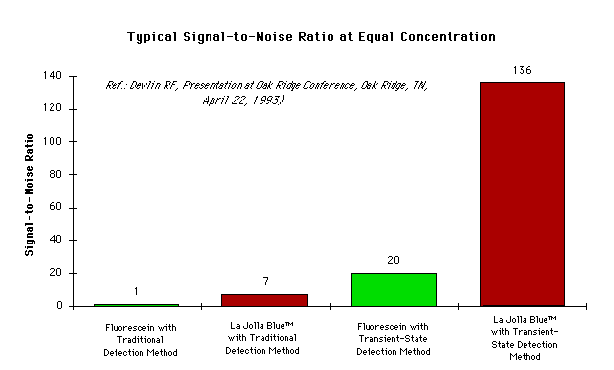Fluorographic imaging and fluorometric measurement have reached widespread use in clinical diagnosis and life science research. In comparison to other techniques, fluorometry and fluorography provide a number of advantages, such as greater convenience, lower cost, and lower occupational hazard. For a variety of applications, however, the sensitivity of traditional fluorescent technology falls substantially short to that of competitive techniques. Typical examples are DNA probes labeled with fluorescein or rhodamine, whose sensitivity compares poorly to that of probes labeled with P-32; and the use of fluorometry in immunoassay which does not approach the sensitivity of ELISA. Fluorescence Polarization Immunoassay (FPIA) can be used as an example to illustrate this point.
FPIA is less cumbersome, less time consuming and less expensive than ELISA, as it foregoes a number of steps that are typical for enzyme immunoassays. It is a homogeneous assay which does not require the separation of bound and unbound fractions; and there is no need to add an enzyme-antibody conjugate and a substrate. These advantages have, so far, been counterbalanced by a sensitivity which is about 100 times lower than that of ELISA. As a result, the use of FPIA has traditionally been limited to assays which do not require high sensitivity.
FPIA was developed by Walter Dandliker, Ph.D., at that time a Member at the Scripps Clinic and Research Foundation in La Jolla, CA. A number of companies are utilizing this public domain technology as the assay format of commercial FPIA systems used primarily for the monitoring of circulating levels of therapeutic drugs. In continuation of his scientific work, Dr. Dandliker co-founded Diatron Corporation and set out to improve the only shortcoming of his original technology, the low sensitivity. At Diatron, he and his fellow scientists developed a new fluorescent measurement and imaging technique which is more than 100 times more sensitive than traditional fluorometry and fluorography. The SIGNALL Technology consist of two major components: A fluorescent measurement technique referred to as "Transient-State" fluorometry, and a fluorescent dye trade named "La Jolla Blue". The following is a short description of the two components:
In traditional ("steady-state") fluorometry excitation of the fluorophore and measurement of the emitted fluorescence are performed simultaneously. In this technique a substantial amount of scattered light straying from the exciting light beam ("Raleigh and Raman scatter") is registered together with the fluorescent signal. This background noise lowers the signal-to-noise ratio, thus causing poor sensitivity. The new transient-state fluorometry avoids this problem by performing the excitation with a series of short laser pulses and counting photons only in the intervals between the pulses. As the background from the excitation beam decays faster than the emitted fluorescence, transient-state avoids registering most of the Raleigh and Raman scatter, thus resulting in a substantially improved signal-to-noise ratio. As a result, transient-state fluorometry and fluorography are up to 10 to 20 times as sensitive as their steady-state counterparts.
Biological fluids and structures, such as blood or cells, contain a variety of substances that fluoresce. This "intrinsic" or "adventitious" fluorescence lowers the signal-to-noise ratio and affects the sensitivity. La Jolla Blue overcomes this problem. Excitation and emission of this fluorophore occur in the near-infrared region (680 nm and 705 nm, respectively) where adventitious fluorescence is very low. This feature is not unique, as there are other fluorophores which emit in the near-infrared band. La Jolla Blue is, however, specially engineered to provide a number of additional characteristics which contrast sharply with other near-infrared emitting dyes: La Jolla Blue does not bind non-specifically to serum components and cellular elements - a feature very important for in vitro diagnosis and many scientific experiments. In addition, La Jolla Blue does not aggregate in solution and does not quench in aqueous buffers. The replacement of the currently most popular fluorescent label, fluorescein, by La Jolla Blue raises the sensitivity by a factor between 6 and 15 depending on the type of experiment and assay environment.
In addition to the improvement in sensitivity, La Jolla Blue has excellent compounding characteristics: It carries free carboxyl groups for easy linkage via an NHS ester without any adverse effect on the quantum yield and extinction coefficient; and it is readily prepared as a free amino terminated compound. These characteristics make La Jolla Blue an ideal fluorochrome for a large number of applications in clinical diagnosis, life science research and a variety of other fields. By using this dye as the tracer, fluorography of cell elements yields substantially clearer images and more precise information. When using it for immunoassay various analytes can be quantitated in whole blood rather than serum - another substantial improvement in convenience, speed and economy.
The use of La Jolla Blue in combination with transient-state measurement improves the sensitivity of fluorographic imaging and fluorometric measurement by a factor of more than 100. In one special experiment an improvement by a factor of 136 has already been demonstrated and published (see graph below). The SIGNALL Technology further enhances the lead in convenience, speed and economy that the currently used fluorometric assays have over enzymatic procedures. In addition to a large number of other applications the SIGNALL Technology has shown excellent performance in the labeling and detection of DNA probes used in DNA amplification and hybridization techniques.
The applications of the SIGNALL Technology cover a wide range including human and veterinary in vitro diagnostics, detection of environmental pollutants, detection of dangerous contaminants in food, and various aspects of life science research. While not yet proven, there are reasons to assume that the technology may also be useful in human in vivo diagnostics (real-time in-situ imaging in the operating room) and therapeutic medicine (photodynamic therapy).
Diatron has already received FDA clearances for a transient-state polarization fluorometer and a digoxin FPIA kit using La Jolla Blue. Data obtained when performing the digoxin assay in whole blood were shown to be equivalent to those measured in serum.
